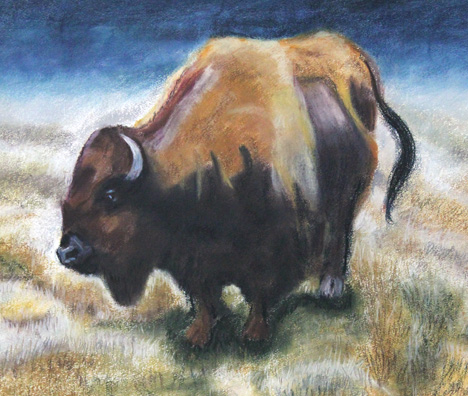Buffalo

Yes, yes, we know this is a bison not a buffalo. But if it looks like a buffalo, walks like a buffalo, and people say it's a buffalo, it's a buffalo.
Of course, the bison (or buffalo if you prefer the common term) is the very embodiment of the culture of the Native Americans of the Great Plains. Everything the tribes had came from the buffalo - from their homes to their tools and weapons to their clothes to their food. You'll read on the Fount of All Knowledge that there were between 60,000,000 to 70,000,000 buffalo in massive herds that extended for miles. Actually buffalo hunters reported that the animals ranged in herds of 20 to 100 animals. The discrepancy is explained that although the animals sometimes could group in huge herds under certain conditions (like when they were stampeding), their usual modus operandi was to split up into the smaller groups. Such behavior has been confirmed by wildlife observers who you think might have saved time by listening to the buffalo hunters.
There were claims of buffalo hunters making up to $20,000 or more, which was good money in the 1870's. Actually a very good hunter would more likely pull in $5000 a year after expenses. That was good money, yes, but not fantastic.
The Fount of All Knowledge cites - inevitably - different levels to which the herds had shrunk by the 1880's - 400 individuals being a common number. However, much of this depends on where you are talking about and sometimes people forget the bison once ranged from Mexico to Alaska. That said, the most accurate census had a count in 1889 of 891 animals for both the US and Canada with 665 were living in the wild.
That the loss of the herds of the plains would render the Indian nomadic life impossible was appreciated by the US government - or at least many individuals in the government, particularly during the administration of President Hiram Grant. Although it may not have been official stated policy, there was a deliberate program to destroy the herds. This is not, by the way, bleeding heart conspiracy-theory claptrap. Frank Mayer - the last known buffalo hunter and who died in 1954 at age 104 - wrote that he could get free ammunition from the army bases and the soldiers told him flat out that the only way to control the Indians (that is, to get them to stay on the ever-shrinking reservations) was to destroy the buffalo. Frank, though, found the army ammunition not to his standards and would reload the cartridges with English powder. After all, if you're going to wipe out a species, you need the best materials you can get.
By the way, the correct term, Frank said, was buffalo "runner", not "hunter". Only a greenhorn would call himself a "hunter".
By 1903, a slight comeback was in evidence with 1753 animals. By 1919, the numbers had risen to 7368, 3118 in the US and 4250 in Canada. Today there are close to half a million animals.
References
The Buffalo Harvest, Frank H. Mayer and Charles B. Roth, Denver Sage Books 1958. Reprint: Pioneer Press, Union City, TN, 1995. Frank was the last known buffalo hunter and his book, written with Charles Roth is an honest appraisal
"Buffalo Hunt: International Trade and the Virtual Extinction of the North American Bison", M. Scott Taylor, Watson Institute, Brown University
The Coming Back of the Bison: Under Government and Private Protection Bison Have Increased", C. Gordon Hewitt, Natural History Magazine, December, 1919.
"The American Bison Society", World Conservation Society, http://www.wcs.org/saving-wildlife/hoofed-mammals/bison/the-american-bison-society.aspx